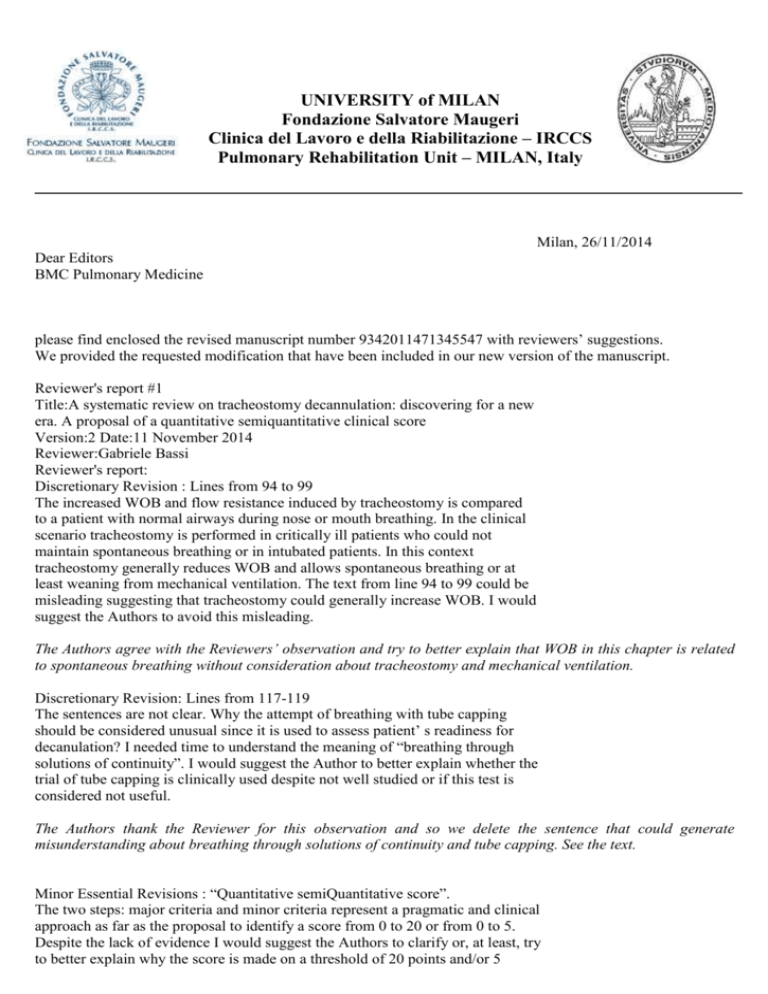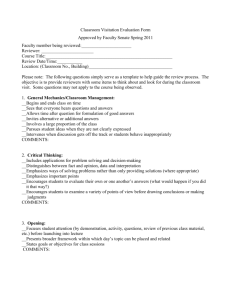Milan, 26/11/2014 Dear Editors BMC Pulmonary Medicine please
advertisement

UNIVERSITY of MILAN Fondazione Salvatore Maugeri Clinica del Lavoro e della Riabilitazione – IRCCS Pulmonary Rehabilitation Unit – MILAN, Italy Milan, 26/11/2014 Dear Editors BMC Pulmonary Medicine please find enclosed the revised manuscript number 9342011471345547 with reviewers’ suggestions. We provided the requested modification that have been included in our new version of the manuscript. Reviewer's report #1 Title:A systematic review on tracheostomy decannulation: discovering for a new era. A proposal of a quantitative semiquantitative clinical score Version:2 Date:11 November 2014 Reviewer:Gabriele Bassi Reviewer's report: Discretionary Revision : Lines from 94 to 99 The increased WOB and flow resistance induced by tracheostomy is compared to a patient with normal airways during nose or mouth breathing. In the clinical scenario tracheostomy is performed in critically ill patients who could not maintain spontaneous breathing or in intubated patients. In this context tracheostomy generally reduces WOB and allows spontaneous breathing or at least weaning from mechanical ventilation. The text from line 94 to 99 could be misleading suggesting that tracheostomy could generally increase WOB. I would suggest the Authors to avoid this misleading. The Authors agree with the Reviewers’ observation and try to better explain that WOB in this chapter is related to spontaneous breathing without consideration about tracheostomy and mechanical ventilation. Discretionary Revision: Lines from 117-119 The sentences are not clear. Why the attempt of breathing with tube capping should be considered unusual since it is used to assess patient’ s readiness for decanulation? I needed time to understand the meaning of “breathing through solutions of continuity”. I would suggest the Author to better explain whether the trial of tube capping is clinically used despite not well studied or if this test is considered not useful. The Authors thank the Reviewer for this observation and so we delete the sentence that could generate misunderstanding about breathing through solutions of continuity and tube capping. See the text. Minor Essential Revisions : “Quantitative semiQuantitative score”. The two steps: major criteria and minor criteria represent a pragmatic and clinical approach as far as the proposal to identify a score from 0 to 20 or from 0 to 5. Despite the lack of evidence I would suggest the Authors to clarify or, at least, try to better explain why the score is made on a threshold of 20 points and/or 5 points. If the Authors do not support the importance of the numeric value of the score I would suggest to better declare it and do not quote the numeric example. We agree with this observation too and so we included the following sentence: “We underline that the twenty point and five points threshold has been chosen a priori, without previously performing an experimental validation; our aim is to highlight the role of objective parameters taken in consideration by most of the studies”. However, in the txt has been reported that this hypothetical score must be validated by a prospectical clinical trial. Reviewer's report #2 Title:A systematic review on tracheostomy decannulation: discovering for a new era. A proposal of a quantitative semiquantitative clinical score Version:2 Date:13 November 2014 Reviewer:Roberto Fumagalli Reviewer's report: Santus P et al. performed a systematic review of the literature about decannulation. The topic is very interesting due to the high frequency of decannulation concerns in clinical practice. A score system is proposed. In general the paper is well done, with an interesting physiological introduction. The score is interesting and supported by literature, even if a prospective evaluation is needed. Due to the speculative nature of the paper I would avoid the inclusion of “discovering for a new era” in the title. The title has been modified as Reviewer suggests In general I have only minor comments. In the score proposed Authors included relevant comorbidities. The adjective “relevant” is difficult to understand. Probably it would be better to add relevant for what (e.g. gas exchange, mechanical properties of the lung, prognosis, etc). Moreover, I would stress the utility of bronchoscopy before and during decannulation (as indicated also in the proposed score: Patent airway). Table 2 has been modified taking in account the Reviewer suggestion. A binary choice has been applied. Moreover as suggested, the clinical importance of bronchoscopy has been underline in the text. Minor comments Background: please explain the abbreviation ETT the first time is cited. At the end of line 102 probably there is a typo mistake (the same in lines 124, and 140). Results: line217-8 (PaO2 and PaCO2 not only here but everywhere in the text). Minor typo mistakes in lines 238, 259, 265, 286, 324, and 325. Score: hypotheses and interpretations: “We suggest an hypothetical score, that requires discussion and validation after convenient modifications in daily practice.” Probably is better to propose a “prospective validation study”. All typo mistakes have been modified. Looking forward to hearing from you at your earliest convenience, I remain Sincerely Yours Pierachille Santus Scientific Institute of Milano – Via Camaldoli, 64 – 20138 – MILAN, Italy










